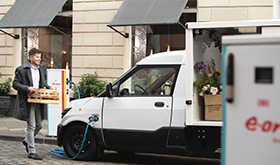

A journey to net zero
Nine steps to net zero
More than 70% of councils across the UK have declared a climate emergency – with many setting stretching targets to achieve net zero by 2030, well before the UK’s legally binding target of 2050 comes into play. Some are in the very earliest stages of that journey, discovering what it might mean to their town, city or community and getting to grips with their baseline data as a starting point. Others are further along and, in dialogue with their local community, are moving the dial away from political declaration towards action planning.
E.ON has been partnering with cities and regions across the UK and Europe for more than 30 years to support their sustainable energy and decarbonisation targets. Building on that experience we’ve developed our nine step journey to help local authorities move at the scale and pace required to achieve net zero carbon.
You can read about the nine steps to building sustainable cities and communities below.
1. Declare climate emergency
Following the lead of the UK Government over two thirds of councils across the UK have declared a climate emergency and many have set local targets to mitigate the impacts of climate change.
Whilst some councils have already made great progress in reducing their carbon emissions, by declaring a climate emergency a local authority is acknowledging that further urgent action is needed.
This public declaration raises the profile, urgency and importance of the transformation of the local energy system and paves the way to the new, integrated approach needed to make net zero happen.
Here’s a full list of councils that have declared a climate emergency and some useful information if you want to do the same but are unsure what steps to take next.

2. Determine city readiness
If your local authority has declared a climate emergency, the next step is to start planning what action to take. The net zero journey cuts across all council departments – from housing, transport and environment through to technology and infrastructure. Being ready to act means understanding the biggest challenges across your community and taking a collaborative approach to tackling them.
This needs leadership from the most senior team in setting the vision and strategy as well as providing a clear governance and decision-making structure. These will help get colleagues from all functions and departments onboard who will play a crucial part in the delivery of the net zero journey.
The people, expertise and investment needed to deliver net zero are substantial. A strategic, collaborative and flexible partnership will equip you with the resources and tools you need to respond to your climate emergency declaration, meet ambitious targets and drive action in the long term.

3. Establish baseline
Once you have secured a trusted partner who shares your vision and has the experience to commit to your energy transition, the starting point for any net zero journey is a thorough understanding of where you are now - an analysis of your baseline data, including the carbon footprint of the council-owned buildings and across the borough more widely.
This analysis should reveal "carbon hotspots" and give you an understanding of where you can have the biggest impact. The baseline data is the starting point from which you can plan and track the progress of your net zero journey.

4. Include & engage all stakeholders
Appropriate engagement with the community will improve the level of decision-making, long-term success and legacy of your net zero strategy.
Good consultation starts with a mapping process that considers the influence all stakeholders have on the success of the programme and the impact it will have on them. This mapping process is followed by an engagement plan, tailored to their needs, a two-way dialogue of openly sharing and exchanging information, understanding different views, listening and responding to suggestions and developing trust.
Consulting with all stakeholders early on and throughout the net zero journey allows residents to influence and shape the decisions made about the places they live and work. It makes sure that even the quieter voices are heard.

5. Set scope & goals
In this step you will first agree the scope of your net zero programme and second, develop clear, aspirational goals which set your net zero course.
The scale of your programme will depend on whether you include Scope 1, 2 or 3 emissions as defined by the Greenhouse Gas Protocol. Scope 1 covers the direct emissions from council buildings and assets, Scope 2 addresses the indirect emissions from the generation of energy used in the borough or city, and Scope 3 includes all other indirect emissions from goods and services created elsewhere but consumed or used within the borough. At this stage you may also consider whether to permit offsetting in those areas where further carbon reductions cannot be made.
The complexity increases as you progress through Scopes 1 to 3 and may need sweeping changes to the way people live, work and travel. Being clear about what is in or out of scope and communicating that effectively, is a crucial step in bringing stakeholders with you.
Regardless of its scope, your net zero journey should be considered through the lens of social value and goals set accordingly. Not only should you agree targets for environmental impacts, such as emissions reduction, air quality improvement and the diversity of local ecosystems, you should also consider goals for positive community impacts, such as improvements in physical and mental health and wellbeing, fuel poverty alleviation, education and job creation. Finally, consider economic indicators, including the impact on economic contribution, inward investment levels, innovation, new products and services, start-ups in connected services and the use of local supply chains.

6. Build action plan & timeline
With clear and ambitious goals in place, you’re ready to develop an action plan that considers the different scenarios available to you and sets the route you will take to deliver and fund your journey to net zero carbon. To develop a sustained programme of action, your plan should first build on quick wins and accelerate the delivery of existing projects, whilst identifying a pipeline of new, innovative and longer-term projects that could be achieved through an integrated approach and collaborative partnerships.
The most effective climate action plans will be flexible and evolve over time, considering new partners, technologies and policies which may give opportunities to catalyse decarbonisation in your town or city.
Your net zero programme creates a sustainable and commercially viable pipeline of projects that will attract investment based on clear, long-term objectives and unlock social value for the communities served.

7. Deliver transformation programme
The implementation phase starts with the understanding of existing assets and takes into account:
- national and local policy landscape
- strategic intent
- technical feasibility
- the availability of grant funding, finance and incentives
- community uptake
These considerations will drive the viability of your transformation programme based on cost (CAPEX and OPEX), return on investment and the benefits gained from the incorporation into a single, smart local energy system.
Your delivery partners will work alongside you to strike the delicate balance between minimising the overall cost of individual and integrated solutions, taking into account their commercial viability, whilst also maximising the impact on emissions reduction and the desired outcomes for the community, articulated at the goal setting stage.

8. Monitor & review effectiveness
Monitoring and evaluation is important to determine the ongoing success of your city-wide energy transformation. Your net zero journey should contain short term key performance indicators (KPIs) and longer-term milestones which allow progress to be tracked on a monthly, quarterly and annual basis. To make sure there is consistency and allow comparison, reporting should be aligned to national or internationally accepted standards.
Whilst social value is a key measurement in identifying whether the city has met and continues to meet its goals and obligations, longer-term socio-economic trends, including changes in society and the progress of technology, create challenges and opportunities which should be periodically reviewed to look at how the city infrastructure can continue to adapt and change with these pressures.

9. Communicate progress & success
Whilst communication is step nine of this net zero framework, it’s a key element of every stage.
Your communication strategy, like your consultation plan, should be a two-way road. No council will achieve net zero without the buy-in and active support from its community members, council officers and political leaders.
As well as being a channel for giving feedback and information about the net zero journey, its challenges and successes, your communications strategy should explore how to promote action on net zero and make it common practice.
This strategy should be tailored to meet the needs of the stakeholders you identified earlier in the journey. We recommend a matrix approach that groups your audience into special interest areas, highlights their key drivers and motivations and delivers your key themes, messages and success stories in a way that is relevant to them and through the channels they are familiar with and already using.



Get in touch
From initiation and mobilisation through to delivery we work in partnership with you to take care of your entire net zero programme. To see how we can help you create smarter, more sustainable cities and communities, get in touch with the City Energy Transformation team.


Take climate action
Find out how you can be more sustainable to help takle climate change.


Sustainable cities and communities
Find out how we're creating smart, sustainable cities and communities across the world.


Sustainable businesses
Find out how to turn your business into an industry leader for sustainability.


Sustainable homes
Find out the many ways in which you can create a more sustainable home and reduce your carbon footprint.